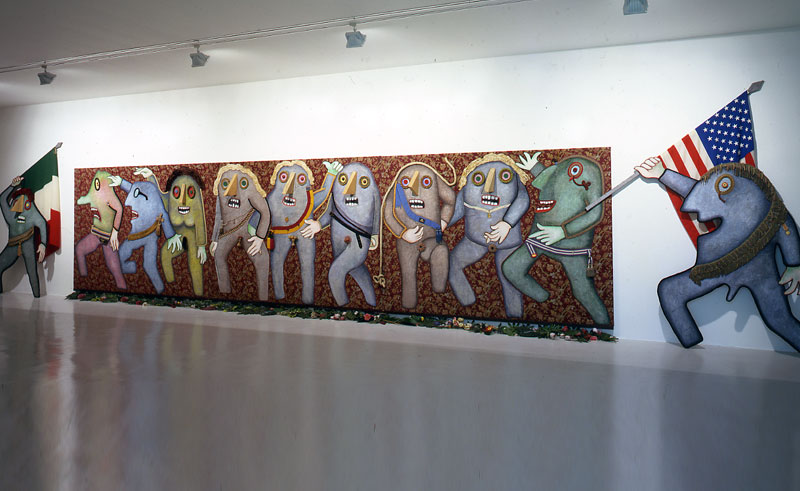On the nine-metre long panel covered in floral fabric, a throng of haughty decorated notables parade from right to left, above a parterre of plastic leaves and flowers. Restless, they walk solemnly gesticulating all the while: six Mafiosi, Golda Meir and then Kissinger and Nixon – on the canvas hung over the work in 1974 could be read – “At the Columbus Day Parade” (made official by none other than the American president in 1971).
Outside the picture, two standard-bearers open and close the parade with Italian and US flags. If in the foremath to this work, The Funerals of the Anarchist Pinelli (1972), Baj had made memorable the “fact” and the tragic circumstances of December 15, 1969, an emblematic episode of a bleak phase of Italian history, now with the Nixon Parade it was Italo-American relationships, Watergate, and international diplomatic relationships that were being commemorated. Using the tools dear to him, i.e. collage and an accumulation of cord, fringes, medals, and plastic frogs and “ghastly flowers” – all the residue of a decadent society and with much deformation and irony, filtered through the lessons of Seurat and above all Picasso, brought to maturity in his recent D’Après Modigliani, Baj rediscovered the pleasure – and urgency – of transcribing “the stages of contemporary history” by reinterpreting them in images.
Indeed, it is history that is the explicit subject of the work, through a “gross” and grotesque representation, an eloquent and uneasy narration like the manner of this parade’s dramatis personae, these feetless giants suspended in the void.
The Nixon Parade is a news bulletin steeped in deformity, of that “fact” and that time, an entirely human “monstrosity”, while the image itself is a tale of the frailty of a world, a taste, and a culture.
Filomena Schettino

